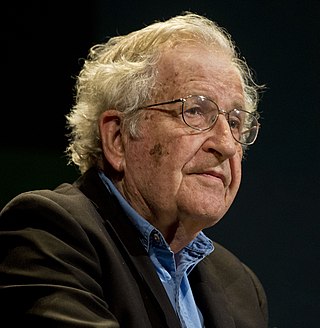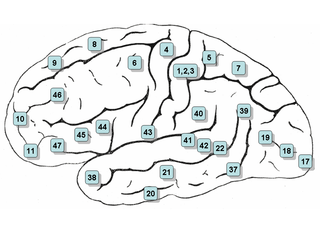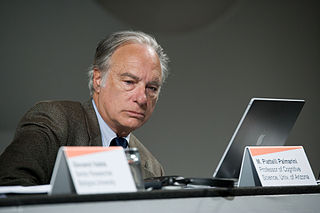Language acquisition is the process by which humans acquire the capacity to perceive and comprehend language, as well as to produce and use words and sentences to communicate.

Universal grammar (UG), in modern linguistics, is the theory of the innate biological component of the language faculty, usually credited to Noam Chomsky. The basic postulate of UG is that there are innate constraints on what the grammar of a possible human language could be. When linguistic stimuli are received in the course of language acquisition, children then adopt specific syntactic rules that conform to UG. The advocates of this theory emphasize and partially rely on the poverty of the stimulus (POS) argument and the existence of some universal properties of natural human languages. However, the latter has not been firmly established, as some linguists have argued languages are so diverse that such universality is rare. It is a matter of empirical investigation to determine precisely what properties are universal and what linguistic capacities are innate.

Neurolinguistics is the study of neural mechanisms in the human brain that controls the comprehension, production, and acquisition of language. As an interdisciplinary field, neurolinguistics draws methods and theories from fields such as neuroscience, linguistics, cognitive science, communication disorders and neuropsychology. Researchers are drawn to the field from a variety of backgrounds, bringing along a variety of experimental techniques as well as widely varying theoretical perspectives. Much work in neurolinguistics is informed by models in psycholinguistics and theoretical linguistics, and is focused on investigating how the brain can implement the processes that theoretical and psycholinguistics propose are necessary in producing and comprehending language. Neurolinguists study the physiological mechanisms by which the brain processes information related to language, and evaluate linguistic and psycholinguistic theories, using aphasiology, brain imaging, electrophysiology, and computer modeling.

Generative grammar, or generativism, is a linguistic theory that regards linguistics as the study of a hypothesised innate grammatical structure. It is a biological or biologistic modification of earlier structuralist theories of linguistics, deriving ultimately from glossematics. Generative grammar considers grammar as a system of rules that generates exactly those combinations of words that form grammatical sentences in a given language. It is a system of explicit rules that may apply repeatedly to generate an indefinite number of sentences which can be as long as one wants them to be. The difference from structural and functional models is that the object is base-generated within the verb phrase in generative grammar. This purportedly cognitive structure is thought of as being a part of a universal grammar, a syntactic structure which is caused by a genetic mutation in humans.
Language transfer is the application of linguistic features from one language to another by a bilingual or multilingual speaker. Language transfer may occur across both languages in the acquisition of a simultaneous bilingual, from a mature speaker's first language (L1) to a second language (L2) they are acquiring, or from an L2 back to the L1. Language transfer is most commonly discussed in the context of English language learning and teaching, but it can occur in any situation when someone does not have a native-level command of a language, as when translating into a second language. Language transfer is also a common topic in bilingual child language acquisition as it occurs frequently in bilingual children especially when one language is dominant.
Second-language acquisition (SLA), sometimes called second-language learning — otherwise referred to as L2acquisition, is the process by which people learn a second language. Second-language acquisition is also the scientific discipline devoted to studying that process. The field of second-language acquisition is regarded by some but not everybody as a sub-discipline of applied linguistics but also receives research attention from a variety of other disciplines, such as psychology and education.
Language development in humans is a process starting early in life. Infants start without knowing a language, yet by 10 months, babies can distinguish speech sounds and engage in babbling. Some research has shown that the earliest learning begins in utero when the fetus starts to recognize the sounds and speech patterns of its mother's voice and differentiate them from other sounds after birth.
Bilingualism, a subset of multilingualism, means having proficiency in two or more languages. A bilingual individual is traditionally defined as someone who understands and produces two or more languages on a regular basis. A bilingual individual's initial exposure to both languages may start in early childhood, e.g. before age 3, but exposure may also begin later in life, in monolingual or bilingual education. Equal proficiency in a bilingual individuals' languages is rarely seen as it typically varies by domain. For example, a bilingual individual may have greater proficiency for work-related terms in one language, and family-related terms in another language.
In the field of psychology, nativism is the view that certain skills or abilities are "native" or hard-wired into the brain at birth. This is in contrast to the "blank slate" or tabula rasa view, which states that the brain has inborn capabilities for learning from the environment but does not contain content such as innate beliefs. This factor contributes to the ongoing nature versus nurture dispute, one borne from the current difficulty of reverse engineering the subconscious operations of the brain, especially the human brain.
Bootstrapping is a term used in language acquisition in the field of linguistics. It refers to the idea that humans are born innately equipped with a mental faculty that forms the basis of language. It is this language faculty that allows children to effortlessly acquire language. As a process, bootstrapping can be divided into different domains, according to whether it involves semantic bootstrapping, syntactic bootstrapping, prosodic bootstrapping, or pragmatic bootstrapping.
The critical period hypothesis or sensitive period hypothesis claims that there is an ideal time window of brain development to acquire language in a linguistically rich environment, after which further language acquisition becomes much more difficult and effortful. It is the subject of a long-standing debate in linguistics and language acquisition over the extent to which the ability to acquire language is biologically linked to age. The critical period hypothesis was first proposed by Montreal neurologist Wilder Penfield and co-author Lamar Roberts in their 1959 book Speech and Brain Mechanisms, and was popularized by Eric Lenneberg in 1967 with Biological Foundations of Language.

Biolinguistics can be defined as the study of biology and the evolution of language. It is highly interdisciplinary as it is related to various fields such as biology, linguistics, psychology, anthropology, mathematics, and neurolinguistics to explain the formation of language. It is important as it seeks to yield a framework by which we can understand the fundamentals of the faculty of language. This field was first introduced by Massimo Piattelli-Palmarini, professor of Linguistics and Cognitive Science at the University of Arizona. It was first introduced in 1971, at an international meeting at the Massachusetts Institute of Technology (MIT). Biolinguistics, also called the biolinguistic enterprise or the biolinguistic approach, is believed to have its origins in Noam Chomsky's and Eric Lenneberg's work on language acquisition that began in the 1950s as a reaction to the then-dominant behaviorist paradigm. Fundamentally, biolinguistics challenges the view of human language acquisition as a behavior based on stimulus-response interactions and associations. Chomsky and Lenneberg militated against it by arguing for the innate knowledge of language. Chomsky in 1960s proposed the Language Acquisition Device (LAD) as a hypothetical tool for language acquisition that only humans are born with. Similarly, Lenneberg (1967) formulated the Critical Period Hypothesis, the main idea of which being that language acquisition is biologically constrained. These works were regarded as pioneers in the shaping of biolinguistic thought, in what was the beginning of a change in paradigm in the study of language.

Laura-Ann Petitto is a cognitive neuroscientist and a developmental cognitive neuroscientist known for her research and scientific discoveries involving the language capacity of chimpanzees, the biological bases of language in humans, especially early language acquisition, early reading, and bilingualism, bilingual reading, and the bilingual brain. Significant scientific discoveries include the existence of linguistic babbling on the hands of deaf babies and the equivalent neural processing of signed and spoken languages in the human brain. She is recognized for her contributions to the creation of the new scientific discipline, called educational neuroscience. Petitto chaired a new undergraduate department at Dartmouth College, called "Educational Neuroscience and Human Development" (2002-2007), and was a Co-Principal Investigator in the National Science Foundation and Dartmouth's Science of Learning Center, called the "Center for Cognitive and Educational Neuroscience" (2004-2007). At Gallaudet University (2011–present), Petitto led a team in the creation of the first PhD in Educational Neuroscience program in the United States. Petitto is the Co-Principal Investigator as well as Science Director of the National Science Foundation and Gallaudet University’s Science of Learning Center, called the "Visual Language and Visual Learning Center (VL2)". Petitto is also founder and Scientific Director of the Brain and Language Laboratory for Neuroimaging (“BL2”) at Gallaudet University.
The Modular Online Growth and Use of Language (MOGUL) project is the cover term name for any research on language carried out using the Modular Cognition Framework (MCF).
Crosslinguistic influence (CLI) refers to the different ways in which one language can affect another within an individual speaker. It typically involves two languages that can affect one another in a bilingual speaker. An example of CLI is the influence of Korean on a Korean native speaker who is learning Japanese or French. Less typically, it could also refer to an interaction between different dialects in the mind of a monolingual speaker. CLI can be observed across subsystems of languages including pragmatics, semantics, syntax, morphology, phonology, phonetics, and orthography. Discussed further in this article are particular subcategories of CLI—transfer, attrition, the complementarity principle, and additional theories.
The mental lexicon is defined as a mental dictionary that contains information regarding the word store of a language user, such as their meanings, pronunciations, and syntactic characteristics. The mental lexicon is used in linguistics and psycholinguistics to refer to individual speakers' lexical, or word, representations. However, there is some disagreement as to the utility of the mental lexicon as a scientific construct.
Syntactic bootstrapping is a theory in developmental psycholinguistics and language acquisition which proposes that children learn word meanings by recognizing syntactic categories and the structure of their language. It is proposed that children have innate knowledge of the links between syntactic and semantic categories and can use these observations to make inferences about word meaning. Learning words in one's native language can be challenging because the extralinguistic context of use does not give specific enough information about word meanings. Therefore, in addition to extralinguistic cues, conclusions about syntactic categories are made which then lead to inferences about a word's meaning. This theory aims to explain the acquisition of lexical categories such as verbs, nouns, etc. and functional categories such as case markers, determiners, etc.
Statistical learning is the ability for humans and other animals to extract statistical regularities from the world around them to learn about the environment. Although statistical learning is now thought to be a generalized learning mechanism, the phenomenon was first identified in human infant language acquisition.
Marit Kristine Richardsen Westergaard is a Norwegian linguist, known for her work on child language acquisition and multilingualism.
Suzanne Flynn is an American linguist and Professor of Linguistics at MIT who has contributed to the fields of second and third language acquisition. She has also investigated language disorders.





